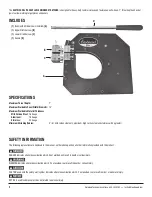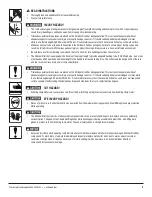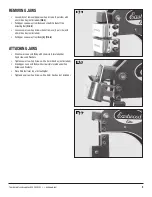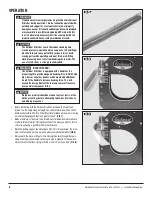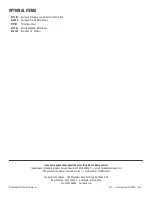
• Before fabricating with the Shrinker Stretcher, pre-bend the metal to be
formed to a 90˚ angle along its length on a sheet metal brake (The #14042
Eastwood Versa Bend 20 Inch Offset Sheet Metal Brake works well), creating
a maximum flange depth that is no greater than 7”
(FIG 7)
.
• Make a template of the piece to be formed out of medium bodied cardboard
or manila folder material. Tracing the outline of the piece you want to form is
critical to achieving a good fit with minimal filler use.
• Work the leading edge of the metal piece first. This “breaks down” the maxi-
mum resistance and permits easy and accurate working thereafter
(FIG 8)
.
• Always work the piece a little at a time moving the piece through the Jaws
along its entire planned length so that each area is exposed to the Jaws nu-
merous times rather than trying to shrink or stretch “all in one bite”
(FIG 9)
.
6
Eastwood Technical Assistance: 800.343.9353 >> [email protected]
FIG. 7
FIG. 8
FIG. 9
Tremendous external torque loads are placed on this Shrinker
Stretcher during operation. This tool cannot be operated with-
out adequate support or severe personal injury or property
damage can occur if it should suddenly be become dislodged
or moves while in use. Before beginning ANY work with this
tool, it is absolutely necessary that it be securely bolted to a
properly anchored heavy, sturdy, workbench or stand.
The Shrinker Stretcher exerts tremendous bending and
crushing forces in operation which can present a hand/finger
pinch hazard and cause potentially serious injuries. Avoid
moving parts while operating and wear thick, well-fitting
work gloves to prevent cuts from handling sharp metal. The
use of safety shoes is strongly recommended.
INJURY HAZARD!
The Shrinker Stretcher is equipped with a Handle of the
proper length to provide adequate bending force. DO NOT add
pipe, bars or any other devices which would add additional
length to the Handle to increase bending force. This will
exceed the design limits of the tool and can result in severe
injury and/or component failure.
Workpiece material should be clean of any rust, burrs, nicks,
welds or coatings before attempting to bend or interference
and binding may occur.
OPERATION


